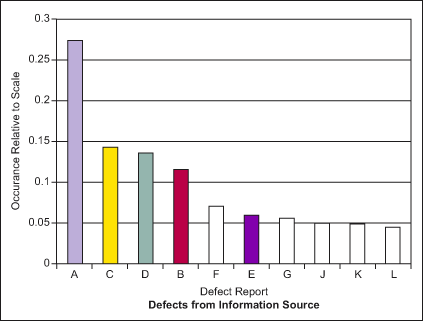
The beauty of Six Sigma, over other decision-making strategies is that it is, by nature, data driven – it involves making decisions backed by evidence. In the absence of data, then, what good is Six Sigma? A Black Belt without data is like a navigator without a compass; finding north becomes complicated, but not impossible. Like a good navigator, a good Black Belt also has the tools to find their way in unfamiliar territory, recognizing that they have more than one set of skills to set direction.
On a recent assignment, a team of Black Belts faced the obstacle described above – a lack of data. With this particular client, the Black Belt team was faced with a limited amount of historical defect data and no current real-time data on the process. After numerous failed attempts to obtain this data, the team was forced to return to basics – pencil and paper – and to rely on a dose of political savvy, interpersonal communication and process owner knowledge.
Polling to Collect Defect Information
Borrowing from the methodologies for affinity diagramming, the team polled line-level operation employees. The respondents consisted of approximately 15 associates, balanced among three distinct departments of a sequential operation – product created in Department 1, modified in Department 2, and assembled in Department 3. Each participant was given five sticky notes and instructed to write down the five most common defects that they see on a daily basis. The notes were then grouped into logical categories and presented as a Pareto chart (Figure 1).

Although not derived from verifiable data, the Pareto of defects based on the affinity opinion poll painted a clear picture of the state of the process and offered a well-defined path to initiate root cause analysis. Based on these findings, the Black Belts made project recommendations to steer the organization toward addressing the most common defects.
Comparing Opinions with Real Data
Sometime thereafter, the flow of real data commenced (Figure 2), allowing the team the opportunity to not only act based on the actual data, but also to compare this data with the recent opinion poll. The results were enlightening.

The opinion poll was in startling agreement with the data-based defect report. Following the Pareto principle, which states that 80 percent of all defects are caused by only 20 percent of the defined defect types, the 80 percent waterline was located, and this equated to the top six defects from both information sources, which were in 83 percent agreement with one another. More simply, five of the top six defects on the opinion poll were also among the top six defects on the defect report. The top four defects from each source were in 100 percent agreement.
Slight disagreement in the absolute rank of these defects, with only a 50 percent correlation, puts into question the statistical significance of the exercise. From a practical standpoint, however, both information sources led to the same recommendations: Focus on finding the root causes for Defects A, B, C and D. Closer inspection of the data also reveals that it is only Defect B that falls out of rank between the two reports. Without B there is a 1:1 defect rank correlation between reports.
Calling On Available Resources
Although real data is always preferred, in the absence of data, it has been demonstrated that a valid direction can still be found through a creative approach and good old-fashioned interpersonal communication. After all, an 83 percent accurate compass is better than no compass at all. The success of such an approach is truly a testament to the knowledge of the line-level operators, often a wealth of untapped information and experience, a resource these Black Belts will remember to keep handy.